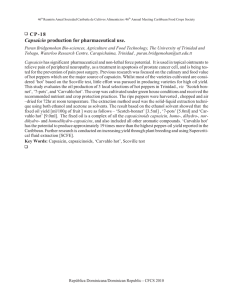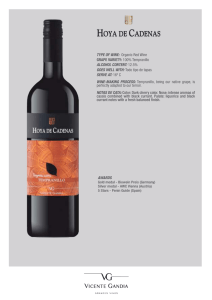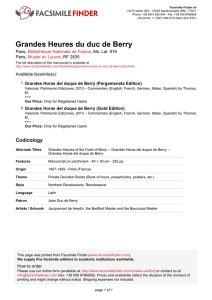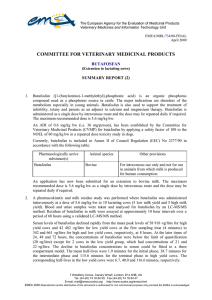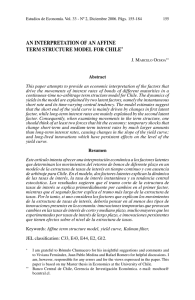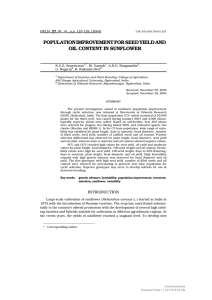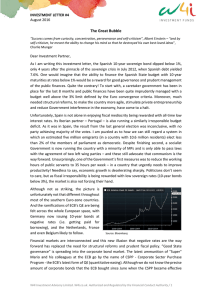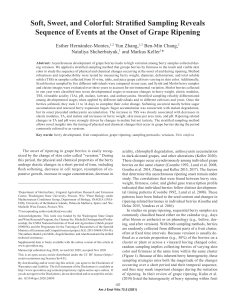Comparison of different methods of grapevine yield prediction in the
Anuncio
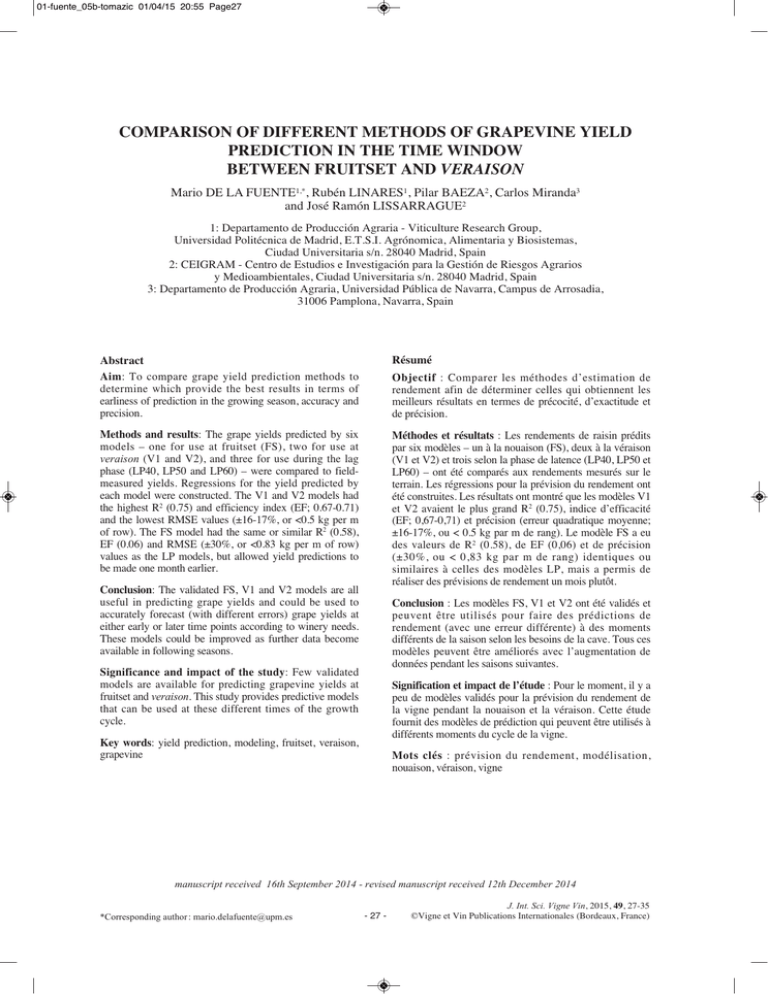
01-fuente_05b-tomazic 01/04/15 20:55 Page27 COMPARISON OF DIFFERENT METHODS OF GRAPEVINE YIELD PREDICTION IN THE TIME WINDOW BETWEEN FRUITSET AND VERAISON Mario DE LA FUENTE1,*, Rubén LINARES1, Pilar BAEZA2, Carlos Miranda3 and José Ramón LISSARRAGUE2 1: Departamento de Producción Agraria - Viticulture Research Group, Universidad Politécnica de Madrid, E.T.S.I. Agrónomica, Alimentaria y Biosistemas, Ciudad Universitaria s/n. 28040 Madrid, Spain 2: CEIGRAM - Centro de Estudios e Investigación para la Gestión de Riesgos Agrarios y Medioambientales, Ciudad Universitaria s/n. 28040 Madrid, Spain 3: Departamento de Producción Agraria, Universidad Pública de Navarra, Campus de Arrosadia, 31006 Pamplona, Navarra, Spain Résumé Abstract Aim: To compare grape yield prediction methods to determine which provide the best results in terms of earliness of prediction in the growing season, accuracy and precision. Objectif : Comparer les méthodes d’estimation de rendement afin de déterminer celles qui obtiennent les meilleurs résultats en termes de précocité, d’exactitude et de précision. Methods and results: The grape yields predicted by six models – one for use at fruitset (FS), two for use at veraison (V1 and V2), and three for use during the lag phase (LP40, LP50 and LP60) – were compared to fieldmeasured yields. Regressions for the yield predicted by each model were constructed. The V1 and V2 models had the highest R2 (0.75) and efficiency index (EF; 0.67-0.71) and the lowest RMSE values (±16-17%, or <0.5 kg per m of row). The FS model had the same or similar R2 (0.58), EF (0.06) and RMSE (±30%, or <0.83 kg per m of row) values as the LP models, but allowed yield predictions to be made one month earlier. Méthodes et résultats : Les rendements de raisin prédits par six modèles – un à la nouaison (FS), deux à la véraison (V1 et V2) et trois selon la phase de latence (LP40, LP50 et LP60) – ont été comparés aux rendements mesurés sur le terrain. Les régressions pour la prévision du rendement ont été construites. Les résultats ont montré que les modèles V1 et V2 avaient le plus grand R2 (0.75), indice d’efficacité (EF; 0,67-0,71) et précision (erreur quadratique moyenne; ±16-17%, ou < 0.5 kg par m de rang). Le modèle FS a eu des valeurs de R2 (0.58), de EF (0,06) et de précision (±30%, ou < 0,83 kg par m de rang) identiques ou similaires à celles des modèles LP, mais a permis de réaliser des prévisions de rendement un mois plutôt. Conclusion: The validated FS, V1 and V2 models are all useful in predicting grape yields and could be used to accurately forecast (with different errors) grape yields at either early or later time points according to winery needs. These models could be improved as further data become available in following seasons. Conclusion : Les modèles FS, V1 et V2 ont été validés et peuvent être utilisés pour faire des prédictions de rendement (avec une erreur différente) à des moments différents de la saison selon les besoins de la cave. Tous ces modèles peuvent être améliorés avec l’augmentation de données pendant les saisons suivantes. Significance and impact of the study: Few validated models are available for predicting grapevine yields at fruitset and veraison. This study provides predictive models that can be used at these different times of the growth cycle. Signification et impact de l’étude : Pour le moment, il y a peu de modèles validés pour la prévision du rendement de la vigne pendant la nouaison et la véraison. Cette étude fournit des modèles de prédiction qui peuvent être utilisés à différents moments du cycle de la vigne. Key words: yield prediction, modeling, fruitset, veraison, grapevine Mots clés : prévision du rendement, modélisation, nouaison, véraison, vigne manuscript received 16th September 2014 - revised manuscript received 12th December 2014 *Corresponding author : [email protected] - 27 - J. Int. Sci. Vigne Vin, 2015, 49, 27-35 ©Vigne et Vin Publications Internationales (Bordeaux, France) 01-fuente_05b-tomazic 01/04/15 19:29 Page28 Mario DE LA FUENTE et al. INTRODUCTION information on phenological and climatological variables collected over the years. These methods require the inspection of the number of clusters per vine, the number of berries per cluster, and berry weight (Dunn, 2010; Sabbatini et al., 2012). The first two variables can usually be determined accurately by sampling at veraison, i.e., quite early in the growth cycle. The main source of variation lies in the predicted berry weight; the quality of any yield prediction is therefore strongly determined by how accurately this can be forecast. The prediction of grape yields is necessary to prevent under- and over-cropping and thus help produce healthy plants and optimum amounts of fruit each season. Predicting yields accurately and early in the grapevine growth cycle is important since it allows adjustments of cluster load to be made (cluster thinning), thus promoting ripening and better grape quality. Yield predictions also allow wineries to determine their space, machinery and staff requirements during the harvest period. However, yields are affected by region, weather, soil conditions, cultivar, rootstock, vine heterogeneity, etc., and significant variations in vineyard yield may be recorded between years, and even between plants (Clingeleffer et al., 2001; Sabbatini et al., 2012); yields can, therefore, be difficult to predict. Berry weight can be anticipated in several ways. A relatively simple and commonly used method is to rely on historical data for average berry weight at harvest (Dami, 2006; Barajas et al., 2010). However, such method may not always be very accurate since it usually does not take into account all the variables that might affect a crop in any particular year. Other methods employ the idea that berry weight at a particular phenological stage is related to its final weight via a coefficient. Sabbatini et al. (2012) described a berry weight prediction method based on the idea that, during the lag phase, berry weight is approximately 50% of its final weight (Coombe and McCarthy, 2000). Thus, growers could predict yields at harvest by simply multiplying the number of plants by the average number of clusters, and multiplying this figure by double the average lag phase cluster weight (obtained by sampling). However, this requires the lag phase to be accurately identified (Sabbatini et al., 2012). Further, the 50% value suggested may differ from region to region. Grapevine reproductive structures present in one year begin their development in the previous growth cycle. For example, the cluster primordia of any year in question always begin their development at the end of spring/early summer inside the buds of the previous year. Their differentiation is halted during winter when the buds are dormant, but continues in the following spring over a short period just before budbreak (Howell, 2001; May, 2000 and 2004). Thus, grapevine reproductive behaviour is affected by the environmental conditions of both the present and previous year. This needs to be taken into account when vineyard management decisions are made. In recent years, a number of methods have been suggested for predicting vineyard yields. Some indirect real-time methods (Tarara et al., 2005) involve placing load cells on row support wires. Variations in the tension of the wire provide indications of the crop level at the moment of measurement. Such information on the dynamics of berry growth can be used to inform management decisions during the growth cycle. However, berry growth dynamics prior to ripening may vary greatly between years; this may require certain adjustments in any function used to predict yield (Tarara and Blom, 2009; Tarara et al., 2014). Barajas et al. (2010) and Nuske et al. (2011) suggested that yields can be predicted from the simple relationship between final berry weight and historical yields at harvest. Pool et al. (1993), Bates (2008) and Sun et al. (2012) suggested the use of growing degree days (GDD) to determine when berry weight reaches approximately 50% of its final weight (between 1000-1700 according to Sabbatini et al. [2012]). Multiplying this weight by two and then relating this figure to historical yield data provides a prediction for the present year. Naturally, yield predictions need to be made after any required cluster thinning. Cluster thinning is best performed 20-30 days after flowering, normally between fruitset and veraison (Dokoozlian and Hirschfelt, 1995; Keller et al., 2005; Sabbatini et al., 2012; Sun et al., 2012). Yield predictions are therefore best made after veraison. Several authors (Dobrowski et al., 2003; Dunn and Martin, 2004; Martínez-Casasnovas and Bordes, 2005; Nuske et al., 2011; Diago et al., 2012) have constructed models for making yield predictions based on digital, aerial or satellite images. All have shown good predictive capacity but require costly imaging and remote sensing operations. Vineyard’s yields can, however, be predicted using more traditional methods based on yield components and J. Int. Sci. Vigne Vin, 2015, 49, 27-35 ©Vigne et Vin Publications Internationales (Bordeaux, France) Yields can also be predicted from cluster weight. However, the results can be misleading due to annual - 28 - 01-fuente_05b-tomazic 01/04/15 19:29 Page29 variation in berry weight and berry number per cluster (Sabbatini et al., 2011 and 2012). seasons (2004-2007). Each plot involved two rows of 25 plants, surrounded by border vines. Yield component data were collected from 30 plants (15 in each row) at fruitset and harvest, and from 20 plants (10 in each row) at veraison (which requires cluster removal). Table 1 shows the varieties planted in each vineyard, their rootstocks, and yield data for 20042007. The phenology of each variety varied slightly. Yield predictions can be attempted at any time during the growth cycle, although they become more accurate later in the cycle (Folwell et al., 1994). Early prediction, however, is important in vineyard and winery management, but none of the more traditional methods mentioned above are very reliable and there are only few grapevine models available (García de Cortázar-Atauri, 2006; Santos et al., 2011; Cola et al., 2014; Parker et al., 2011). The present work compares the grape yields predicted by six models – one for use at fruitset (FS), two for use at veraison (V1 and V2), and three for use during the lag phase (LP40, LP50 and LP60) – with observed yields to determine which provide results with an acceptable error earliest in the growing season. 2. Construction of models for predicting yield The grape yields predicted by six models – one for use at fruitset (FS), two for use at veraison (V1 and V2), and three for use during the lag phase (LP40, LP50 and LP60) – were compared to observed yields (kg per m of row). 1. FS model. This model required: i) counting the number of clusters per plant from 30 plants (15 per row) per replicate in each vineyard (total of 120 plants per vineyard) at fruitset and ii) recording the mean cluster weight at harvest from the historical dataset for each vineyard. MATERIALS AND METHODS 1. Experimental vineyards The present work involved 14 vineyards (total surface over 700 ha) at the “El Jaral” estate in Malpica del Tajo (Toledo, Spain; 44º14’N, 3º58’W). The growing area has a Mediterranean climate with more than 2000 GDD each season. Plant rows were NW-SE oriented; spacing was 2.7 x 1.2 m. Irrigation drippers (3·L h-1) were spaced 1.2 m apart in each row (one per plant); all plants received the same amount of water in the same year. Plants were grown on trellises (bilateral cordons), vertical-shoot-position (VSP) trained, and spur-pruned. 2. Veraison model 1 (V1). This model required: clusters from 20 plants per replicate to be removed at veraison and weighed using a JADEVER® JCA Series balance (maximum capacity 60 kg; accurate to 1 g). The mean cluster weight for each vineyard was multiplied by a coefficient K1 (Eq. 1) describing the relationship between berry weight at veraison and harvest: Four plots (total area covered 1296 m 2 ) were established in each vineyard during four consecutive Table 1 – Mean number of clusters, final cluster weight (g) and final yield (kg per m of row) (means ± SD) for each vineyard between 2004 and 2007. Experimental Vineyards Variety Rootstock 1 2 3 4 5 6 7 8 9 10 11 12 13 14 Petit Verdot Cabernet-Sauvignon Cabernet-Sauvignon Cabernet-Sauvignon Cabernet-Sauvignon Cabernet-Sauvignon Cabernet-Sauvignon Merlot Merlot Syrah Syrah Syrah Merlot Merlot 420A 110R 110R 3309C 3309C 1103P 1103P SO4 3309C 110R 110R SO4 110R 110R Clusters/m (N) ! 23.46 32.48 33.88 37.92 30.71 30.03 27.27 31.41 23.46 24.44 22.55 28.14 37.56 36.83 SD 3.04 16.19 12.86 18.03 18.24 16.97 9.03 12.15 10.7 8.55 8.67 11.26 14.08 13.27 - 29 - Final Cluster Weight (g) ! 132.95 108.99 91.36 94.91 95.81 90.11 127.11 108.58 147.05 101.36 179.81 148.88 124.17 124.87 SD 23.26 19.79 21.9 20.78 15.97 16.18 41.63 32.11 33.59 16.14 50.96 42.6 24.79 23.6 Final Yield (kg/m) ! 3.07 3.25 2.88 2.83 2.55 2.5 2.84 2.64 2.46 2.08 2.87 4.09 4.22 4.24 SD 0.72 1.26 1.05 0.98 0.99 0.91 0.55 0.49 0.41 0.29 0.74 0.94 1.06 1.06 J. Int. Sci. Vigne Vin, 2015, 49, 27-35 ©Vigne et Vin Publications Internationales (Bordeaux, France) 01-fuente_05b-tomazic 01/04/15 19:29 Page30 Mario DE LA FUENTE et al. Table 2 – Mean dates at which the different phenological stages were reached, and GDD data (budbreak-harvest) for each variety between 2004 and 2007. 1 GDD = growing degree days where Yr is the estimated yield per m of row, Yo is the independent term of the regression equation, P is the number of plants per m of row, C is the number of clusters per plant, Cw is the cluster weight, µ is the error, and the subscript i refers to the year and replicate in question. All regressions (Eq. 5) were calculated using the IBM-SPSS v.19 PROC REG routine and then compared by ANOVA using the same software. where N is the number of years involved in the calculation of the mean yield, n = i refers to the first year of the data range, k refers to the last year of the data range, and K1i is determined via Equation 2: 3. Veraison model 2 (V2). This model is the same as that above but employs the coefficient K2 (Eq. 3), obtained as follows: 3. Model comparison and validation The models were compared and validated based on two criteria extensively used in plant models (Bellocchi et al., 2010; Miranda et al., 2013) and taking into account the following (Eq. 6): where N is the number of years involved in the calculation of the mean yield, n = i refers to the first year of the data range, k refers to the last year of the data range, and K2i is determined via Equation 4: (i) the efficiency index (EF), a normalized statistic that determines the proportion of variance explained by the model, and (i) the root mean squared error (RMSE), a residualbased measure that provides the mean error of the prediction (expressed in kg per m of row). 4. Lag phase models (LP40, LP50 and LP60). These models are all based on the idea that, at lag phase, berry weight is approximately 50% of its final weight (Coombe and McCarthy, 2000). However, these models assume that, at lag phase, the berry weight reached is in fact 40% (LP40), 50% (LP50) or 60% (LP60) of final berry weight. Yield predictions were calculated as for the above V1 and V2 models, but substituting K1 or K2 for the KLP coefficient, which has a value of 5/2, 2.0 and 5/3 for the LP40, LP50 and LP60 models, respectively. where Oi is the observed value, Pi is the predicted value, O is the mean observed value, and n is the number of observations. Finally, graphical procedures (Bland and Altman, 1986; Mayer and Butler, 1993 in Miranda et al., 2013) were used to compare the yields predicted at harvest by each model to those observed. Scatter plots were drawn and the line of equality (on which all points would lie if the observed and estimated values were exactly the same) drawn. The lack of The performance of these six models in predicting the observed yield was determined using Equation 5: J. Int. Sci. Vigne Vin, 2015, 49, 27-35 ©Vigne et Vin Publications Internationales (Bordeaux, France) - 30 - 01-fuente_05b-tomazic 01/04/15 19:29 Page31 Table 3 – Relationship between observed and predicted yields and R2 values for the six prediction models. All model equations had p values of 0.0001 Yieldp = average predicted yield (the average observed yield was 2.9 kg per m of row) 1 2 To analyse the predictive ability of the models, the differences between observed and predicted yields were plotted against the observed yields (Fig. 2). The mean differences (µ) between observed and predicted yields are shown as solid lines (always <1.0 kg). The FS, LP40, LP50 and LP60 models tended to overestimate yield in low yielding plots and to underestimate yield in high yielding plots. These effects were more severe for the FS (µ = -0.53 kg) and LP40 (µ = -0.7 kg) models, which had values of around µ = ±0.2 kg. agreement between the observed yields and those predicted by each model was examined by calculating the relative bias using a Bland and Altman graph (Miranda et al., 2013), which takes into account the mean (µ) and the standard deviation (SD) of the differences. The interval defined by µ ± 2SD (limits of agreement) was calculated for each model. All the models were then subjected to validation using independent real and observed datasets. DISCUSSION RESULTS The R2 values of the V1 and V2 models were about 15% higher than those of the FS, LP40, LP50 and LP60 models. They also had higher EF values. The FS model had an EF about 0.60 lower than those of V1 and V2 since it did not take into account either berry or cluster weight of the current year - the main source of variability (Sabbatini et al., 2011 and 2012). The EF values of the LP50 (0.05 lower), LP60 (0.27 lower) and LP40 (0.32 higher) models were similar to that of the FS model. These results suggest that yield predictions at fruitset, while not particularly good, might be of some interest given the early point in the growth cycle at which they can be made. Further, fruitset is much easier to identify than the lag phase. It is important to note that the error associated with the FS model can be high, although some wineries might still find the model useful: it Table 3 reveals the differences between the models in terms of R2. The V1 and V2 models had higher R2 values (covering close to 75% of the total variability) than the FS and the three LP models (R2 range 0.580.6). The V1 and V2 models had the best RMSE (generally <0.5 kg) and EF values (Table 4). The FS, LP40 and LP50 models showed similar RMSE values (around 0.83), while LP60 had a slightly lower RMSE value (0.66). The V1 and V2 models had by far the best EF values (0.71 and 0.67, respectively). The LP60 model had an EF of 0.34, but the FS, LP40 and LP50 models had values of just 0.07, -0.26 and 0.11, respectively. Estimated yields were plotted against the observed values (Fig. 1). For all models, the data clustered fairly close to the equality line, and a similar dispersion between the data used for model building and validation was observed. All models (except V1 and V2) had a deviation from the ideal relationship (y = x) around 4-5%, while the V1 and V2 models had only 2.5% deviation, being better fitted. Normality of the model predictive errors was formally assessed using an ANOVA regression test, and their significances (p<0.0001) indicated that residuals adequately approximated normality in all cases. Table 4 – Validation: root mean squared error (RMSE) and efficiency index (EF) values for the six models. Parametric Model Values - 31 - RMSE EF Fruitset (FS) 0.833 0.065 Veraison 1 (V1) 0.460 0.707 Veraison 2 (V2) 0.480 0.670 Lag phase 40% (LP40) 0.915 -0.255 Lag phase 50% (LP50) 0.769 0.114 Lag phase 60% (LP60) 0.664 0.340 J. Int. Sci. Vigne Vin, 2015, 49, 27-35 ©Vigne et Vin Publications Internationales (Bordeaux, France) 01-fuente_05b-tomazic 01/04/15 19:29 Page32 Mario DE LA FUENTE et al. Figure 1 – Observed yields plotted against the yields predicted by each model. The R2 values were validated by ANOVA (p<0.0001). Figure 2 – Differences between Observed (O) and Predicted (P) yields plotted against the observed yields. The solid line is the mean of the differences (µ); the broken lines are the limits of agreement calculated as µ ± SD, where SD is the standard deviation of the differences. the model. Using models involving predictions made at flowering and veraison, Diago et al. (2012) obtained higher RMSE values (0.749 kg) than those shown by the V1 and V2 models, while Parker et al. (2011) obtained similar EF (0.72-0.76) but higher RMSE values. The V1 and V2 yield predictions are reliable for this early stage of the growth cycle. The V1 model provided the best R2 (0.748), EF (0.707) and RMSE (< 0.5 kg per m of row) results. Veraison gives crop and winery managers very early information. The V1 and V2 models had the lowest RMSE values (close to 0.45 kg per m of row). The mean variability for the observed yield data for the plots over 20042007 was 0.82 ± 0.29 kg - an error of <0.5 kg per m of row (Table 1). According to Miranda et al. (2013) and Diago et al. (2012), RMSE values <1 validate J. Int. Sci. Vigne Vin, 2015, 49, 27-35 ©Vigne et Vin Publications Internationales (Bordeaux, France) - 32 - 01-fuente_05b-tomazic 01/04/15 19:29 Page33 models enjoy the advantage of having more information since predictions are made later in the growth cycle. Indeed, both V1 and V2 models are here shown to predict yields rather well. Similar results have been obtained by others using veraison models to predict the yields of fruit trees (Miranda and Royo, 2004) and grapevines (Parker et al., 2011). Some authors report errors in yield predictions of 1015% (Miranda and Royo, 2004; Tarara et al., 2005; Nuske et al., 2011). Yet, others report errors of 20% (Blom and Tarara, 2009) and 30% (Dunn, 2010). The present models were more accurate, especially V1 and V2 – despite being of use relatively early in the growth cycle – and can be considered statistically acceptable since they meet the criteria of Power (1993), i.e., they show no significant predictive bias, adequate accuracy, and the prediction residuals are normally distributed. Correlation coefficients were calculated for each plot to test the null hypothesis that the values provided by the models were not linearly related to the observed yields. Values obtained for the estimation methods were linearly related (R2 = 0.6-0.75; p<0.0001) to the true values. Nuske et al. (2011) obtained a correlation score of R2 = 0.74 when using digital images taken at veraison, while Diago et al. (2012) obtained similar values (R2 = 0.73; p<0.002) during maturation. The present FS and LP models showed more heterogeneity than the V1 and V2 models. The V1 model had the smallest number of outliers. However, correlation analysis is not entirely appropriate for these models (Bland and Altman, 1986; Miranda et al., 2007); graphical analysis of the dispersion of the error provides a clearer view of the relationship between predicted and observed yield (Fig. 2). In the prediction of other variables, such as the timing of a determined phenological stage or the damage that might be caused by disease or frost, simple methods based on easily measured variables are recommended (García de Cortázar-Atauri et al., 2009; Nendel, 2010; Parker et al., 2011; Daux et al., 2012; Miranda et al., 2013). Certainly, the present models, which only take into account berry weight or cluster weight, meet this criterion. The models presented in this paper could be improved year-on-year as observed yield data is collected and used to feed the historical dataset. CONCLUSION The FS, LP40, LP50 and LP60 models tended to overestimate yield in low yielding plots and to underestimate yield in high yielding plots. However, since the deviations were small and constant, these models could be considered reliable (mainly FS), given the early stage in the growth cycle. The V1 and V2 models could be used to accurately predict grapevine yields. Despite the inherent error of the FS model, predictions made at fruitset may be of interest to some wineries that require information as early as possible. With the FS model, the SD of the differences revealed a moderate systematic error (-0.53) and accuracy (error <0.6 kg per m of row in 95% of cases). As the cycle progresses, yield predictions become better. The V1 model showed the best systematic error (0.16) and accuracy (<0.43 kg per m of row in 95% of cases) (Fig. 2). The V2 model had a similar systematic error (-0.16), but showed greater dispersion between observed and predicted yields and less accurate yield predictions (<0.46 kg per m of row in 95% of cases), with a slight tendency to overestimate. The V1 model had the smallest bias of all and provided the best results of all. The LP60 model showed a systematic error of -0.1 but greater bias and less accuracy (0.63 kg per m of row in 95% of cases) than the FS, V1 and V2 models. The LP40 and LP50 models showed higher systematic errors (-0.69 and -0.31, respectively), while their bias, error and accuracy (0.71-0.72 kg per m of row in 95% of cases) compare well with the V1 and V2 models, showing that making predictions when the berries are at 50% of their final weight does not always work well. Acknowledgements: This work was performed as part of an agreement between Osborne Distribuidora S.A. and the Viticulture Research Group of the Universidad Politécnica de Madrid (reference MEC, IDI: P030260221). The author did the works during its research formation at U.P.M. (2004-2008). REFERENCES Barajas E., Yuste J.R., Alburquerque M.V. and Yuste J., 2010. Estimación del rendimiento de Tempranillo en tres densidades de plantación. Vida Rural, 1, 28-31. Bates T., 2008. Pruning level affects growth and yield of New York Concord on two training systems. Am. J. Enol. Vitic., 59, 276-286. Bellocchi G., Rivington M., Donatelli M. and Matthews K., 2010. Validation of biophysical models: issues and methodologies. A review. Agron. Sustain. Dev., 30, 109-130. Bland J.M. and Altman D.G., 1986. Statistical methods for assessing agreement between two methods of clinical measurement. Lancet, 327, 307-310. - 33 - J. Int. Sci. Vigne Vin, 2015, 49, 27-35 ©Vigne et Vin Publications Internationales (Bordeaux, France) 01-fuente_05b-tomazic 01/04/15 19:29 Page34 Mario DE LA FUENTE et al. Blom P.E. and Tarara J.M., 2009. Trellis tension monitoring improves yield estimation in vineyards. HortScience, 44, 678-685. García de Cortázar-Atauri I., Brisson N. and Gaudillere J.P., 2009. Performance of several models for predicting budburst date of grapevine (Vitis vinifera L.). Int. J. Biometeorol., 53, 317-326. Clingeleffer P.R., Martin S.R., Dunn G.M. and Krstic M.P., 2001. Crop Development, Crop Estimation and Crop Control to Secure Quality and Production of Major Wine Grape Varieties: A National Approach. CSIRO and NRE: Victoria, Australia. Howell G.S., 2001. Sustainable grape productivity and the growth-yield relationship: a review. Am. J. Enol. Vitic., 52, 165-174. Keller M., Mills L.J., Wample R.L. and Spayd S.E., 2005. Cluster thinning effects on three deficit-irrigated Vitis vinifera cultivars. Am. J. Enol. Vitic., 56, 91-103. Cola G., Mariani L., Salinari F., Civardi S., Bernizzoni F., Gatti M. and Poni S., 2014. Description and testing of a weather-based model for predicting phenology, canopy development and source-sink balance in Vitis vinifera L. cv. Barbera. Agric. Forest Meteorol., 184, 117-136. Martínez-Casasnovas J.A. and Bordes X., 2005. Viticultura de precisión: predicción de cosecha a partir de variables del cultivo e índices de vegetación. Revista de Teledetección, 24, 67-71. Coombe B.G. and McCarthy M.G., 2000. Dynamics of grape berry growth and physiology of ripening. Aust. J. Grape Wine Res., 6, 131-135. May P., 2000. From bud to berry, with special reference to inflorescence and bunch morphology in Vitis vinifera L. Aust. J. Grape Wine Res., 6, 82-98. Daux V., Garcia de Cortazar-Atauri I., Yiou P., Chuine I., Garnier E., Le Roy Ladurie E., Mestre O. and Tardaguila J., 2012. An open-access database of grape harvest dates for climate research: data description and quality assessment. Clim. Past, 8, 1403-1418. Miranda C. and Royo J.B., 2004. Statistical model estimates potential yields in “Golden Delicious” and “Royal Gala” apples before bloom. J. Amer. Soc. Hort. Sci., 129, 20-25. Dami I., 2006. Methods of crop estimation in grapes. Ohio Grape-Wine Electronic Newsletter, 1-4. May P., 2004. Flowering and Fruitset in Grapevines. Adelaide, Australia: Lythrum Press. Miranda C., Girard T. and Lauri P.E., 2007. Random sample estimates of tree mean for fruit size and colour in apple. Sci. Hortic., 112, 33-41. Diago M.P., Correa C., Millán B., Barreiro P., Valero C. and Tardaguila J., 2012. Grapevine yield and leaf area estimation using supervised classification methodology on RGB images taken under field conditions. Sensors, 12, 16988-17006. Miranda C., Santesteban L.G. and Royo J.B., 2013. Evaluation and fitting of models for determining peach phenological stages at a regional scale. Agric. Forest Meteorol., 178-179, 129-139. Dobrowski S.Z., Ustin S.L. and Wolpert J.A., 2003. Grapevine dormant pruning weight prediction using remotely sensed data. Aust. J. Grape Wine Res., 9, 177-182. Nendel C., 2010. Grapevine bud break prediction for cool winter climates. Int. J. Biometeorol., 54, 231-241. Nuske S., Achar S., Bates T., Narasimham S.G. and Singh S., 2011. Yield estimation in vineyards by visual grape detection. In: Proceedings of the 2011 IEEE/RSJ International Conference on Intelligent Robots and Systems (IROS ‘11), pp. 2352-2358. Dokoozlian N.K. and Hirschfelt D.J., 1995. The influence of cluster thinning at various stages of fruit development on Flame Seedless table grapes. Am. J. Enol. Vitic., 46, 429-436. Dunn G.M. and Martin S.R., 2004. Yield prediction from digital image analysis: a technique with potential for vineyard assessments prior to harvest. Aust. J. Grape Wine Res.,10, 196-198. Parker A.K., Garcia de Cortazar-Atauri I., Van Leeuwen C. and Chuine I., 2011. General phenological model to characterise the timing of flowering and veraison of Vitis vinifera L. Aust. J. Grape Wine Res., 17, 206-216. Dunn G.M., 2010. Yield Forecasting. Australian Government: Grape and wine research and development corporation, Fact sheet June 2010. Pool R.M., Dunst R.E., Crowe D.C., Hubbard H., Howard G.E. and DeGolier G., 1993. Predicting and controlling crop on machine or minimal pruned grapevines. In: Proceedings of the Second Nelson J. Shaulis Grape Symposium: Pruning Mechanization and Crop Control. Pool R.M. (Ed.), NY State Agricultural Experiment Station, pp. 31-45. Folwell R.J., Santos D.E., Spayd S.E., Porter L.H. and Wells D.S., 1994. Statistical technique for forecasting Concord grape production. Am. J. Enol. Vitic., 45, 63-70. Garcia de Cortazar-Atauri I., 2006. Adaptation du modèle STICS à la vigne (Vitis vinifera L.). Utilisation dans le cadre d’une étude d’impact du changement climatique à l’échelle de la France. Thèse de Doctorat, Ecole Supérieure Nationale d’ Agronomie, Montpellier. J. Int. Sci. Vigne Vin, 2015, 49, 27-35 ©Vigne et Vin Publications Internationales (Bordeaux, France) Power M., 1993. The predictive validation of ecological and environmental models. Ecol. Model., 68, 33-50. Sabbatini P., Tozzini L., Howell G.S. and Wolpert J.A., 2011. Analysis of berry growth and maturation as - 34 - 01-fuente_05b-tomazic 01/04/15 19:29 Page35 related to cropping levels and seasonal variation. In: Proceed. 17th Int; GiESCO Symposium, pp. 239-242. Sabbatini P., Dami I. and Howell G.S., 2012. Predicting Harvest Yield in Juice and Wine Grape Vineyards. Extension Bulletin 3186, Michigan State University. Tarara J.M., Blom P.E., Ferguson J.C. and Pierce F.J., 2005. Estimating grapevine yield from measurements of trellis wire tension. In: Proceedings of FRUTIC 05, Information and Technology for Sustainable Fruit and Vegetable Production, pp. 315-324. Sun Q., Sacks G.L., Lerch S.D. and Vanden Heuvel J.E., 2012. Impact of shoot and cluster thinning on yield, fruit composition, and wine quality of Corot noir. Am. J. Enol. Vitic., 63, 49-56. Tarara J.M., Chaves B., Sanchez L.A. and Dokoozlian N.K., 2014. Use of cordon wire tension for static and dynamic prediction of grapevine yield. Am. J. Enol. Vitic., 65, 443-452. Tarara J.M. and Blom P.E., 2009. Modeling seasonal dynamics of canopy and fruit growth in grapevine for application in trellis tension monitoring. HortScience, 44, 334-340. Santos J.A., Malheiro A.C., Karremann M.K. and Pinto J.G., 2011. Statistical modelling of grapevine yield in the Port Wine region under present and future climate conditions. Int. J. Biometeorol., 55, 119-131. - 35 - J. Int. Sci. Vigne Vin, 2015, 49, 27-35 ©Vigne et Vin Publications Internationales (Bordeaux, France)
